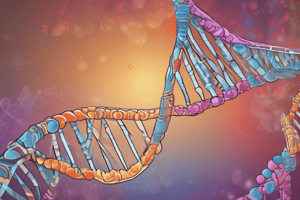Podcast
Questions and Answers
What is the function of DNA in the cell?
What is the function of DNA in the cell?
- To provide energy for the cell
- To carry genetic instructions for growth and development (correct)
- To regulate cell division
- To synthesize proteins
What is the term for the sequence of three bases in a DNA strand?
What is the term for the sequence of three bases in a DNA strand?
- Genotype
- Codon (correct)
- Phenotype
- Genome
During transcription, DNA is transcribed into which type of RNA?
During transcription, DNA is transcribed into which type of RNA?
- Messenger RNA (mRNA) (correct)
- Ribosomal RNA (rRNA)
- Transfer RNA (tRNA)
- Small nuclear RNA (snRNA)
What is the term for the process of creating an identical copy of DNA?
What is the term for the process of creating an identical copy of DNA?
Which of the following is NOT a type of nitrogenous base in DNA?
Which of the following is NOT a type of nitrogenous base in DNA?
What is the purpose of DNA profiling?
What is the purpose of DNA profiling?
What is the term for the building blocks of proteins?
What is the term for the building blocks of proteins?
What is the term for the process of translating mRNA into a specific protein?
What is the term for the process of translating mRNA into a specific protein?
Flashcards are hidden until you start studying
Study Notes
Structure of DNA
- DNA has a unique double-helix structure, resembling a twisted ladder.
- The "rungs" of the ladder are made up of pairs of nucleotides.
- Each nucleotide consists of three parts: a sugar molecule (deoxyribose), a phosphate group, and a nitrogenous base.
- There are four types of nitrogenous bases in DNA: Adenine (A), Thymine (T), Cytosine (C), and Guanine (G).
- The bases pair in a specific way: Adenine always pairs with Thymine (A-T) and Cytosine always pairs with Guanine (C-G).
Function of DNA
- The sequence of bases along a DNA strand forms a code, known as the genetic code.
- The code is read in groups of three bases, called codons.
- Each codon specifies a particular amino acid, which are the building blocks of proteins.
- DNA provides the instructions for making proteins through a process called protein synthesis.
- Protein synthesis involves two main steps: transcription and translation.
- Transcription: DNA is transcribed into messenger RNA (mRNA) in the cell nucleus.
- Translation: mRNA travels to the ribosome in the cytoplasm, where it is translated into a specific protein.
Replication
- DNA can replicate itself, ensuring that each new cell has an identical copy of the DNA.
- Replication is crucial for growth, repair, and reproduction.
Importance of DNA
- DNA variations (mutations) are the source of genetic diversity in populations, driving evolution and adaptation.
- DNA is passed from parents to offspring, carrying traits from one generation to the next.
- Understanding DNA helps us comprehend how organisms are built and how they function at a molecular level.
- It also opens the door to biotechnological advances, such as genetic engineering and medical research.
Protein Synthesis
- Proteins are built from amino acids, which are specified by codons in the DNA code.
- Protein synthesis involves the translation of mRNA into a specific protein.
RNA
- Messenger RNA (mRNA) is a type of RNA that carries genetic information from DNA to the ribosome.
- mRNA is transcribed from DNA in the cell nucleus.
tRNA and Codon
- tRNA (transfer RNA) carries amino acids to the ribosome during protein synthesis.
- Each tRNA molecule has a specific anticodon that binds to a specific codon on the mRNA.
- The codon specifies the amino acid that the tRNA carries.
Studying That Suits You
Use AI to generate personalized quizzes and flashcards to suit your learning preferences.




